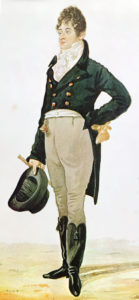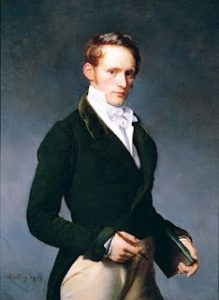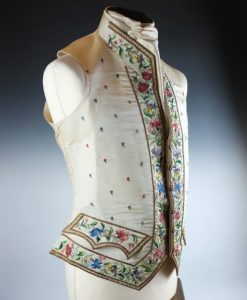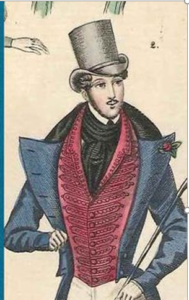
By the Regency Era in England, men’s fashions had undergone dramatic transformation. This happened largely in part to the French revolution when displaying one’s aristocratic wealth might result in the loss of one’s head. Since the British often followed the French, that trend of dressing in a simpler manner came to England, as well. A surprisingly influential English gentleman named Beau Brummel facilitated this new, less ornate style into a true British fashion statement. This new style highlighted a tailor’s skill and the quality of the fabric as a sign of distinction. For a change, French fashion took their cues from the English.
Despite the new simpler fashions, Regency men’s attire was decidedly more complex than that of today. To help solve the mystery of the various layers and terminology of the Regency man’s attire, I will address the Regency men’s waistcoat.
 Over a shirt and braces (suspenders), gentlemen wore a waistcoat. Pronounced “weskit,” it is nothing more than a vest. To evening affairs, a stylish gentleman wore either a crisp white or pure black waistcoat made of silk or cashmere, such as this fine gentleman to the right is wearing. The waistcoat often included ornate embroidery.
Over a shirt and braces (suspenders), gentlemen wore a waistcoat. Pronounced “weskit,” it is nothing more than a vest. To evening affairs, a stylish gentleman wore either a crisp white or pure black waistcoat made of silk or cashmere, such as this fine gentleman to the right is wearing. The waistcoat often included ornate embroidery.
F or daytime, waistcoats in bright colors and patterns–primarily stripes–and often intricately embroidered were popular, although some gentlemen seemed to prefer plainer colors or simply white, even during the day. This photo to the left is of an embroidered waistcoat featuring flowers and vines. Dandies, especially, fancied bright colors and patterns. They sometimes wore them (under disapproving eyes) for evening wear as well.
or daytime, waistcoats in bright colors and patterns–primarily stripes–and often intricately embroidered were popular, although some gentlemen seemed to prefer plainer colors or simply white, even during the day. This photo to the left is of an embroidered waistcoat featuring flowers and vines. Dandies, especially, fancied bright colors and patterns. They sometimes wore them (under disapproving eyes) for evening wear as well. 
The waistcoat was cut long enough to be seen above and below the buttoned tailcoat, and could be straight across or come down to a point or two. Waistcoats covered the top of the breeches (pronounced “britches”). They often sported lapels or wide collars which could be turned fashionably up to frame the neckcloth. Most examples I have seen of waistcoats came with at least one small pocket, perfect for a fob watch, a handkerchief, calling cards, or even a coin or two.
 The waistcoat buttoned up the front, and could be either single- or double-breasted. Single-breasted seems to have been more in vogue for evening wear. Waistcoat buttons were usually covered with matching cloth.
The waistcoat buttoned up the front, and could be either single- or double-breasted. Single-breasted seems to have been more in vogue for evening wear. Waistcoat buttons were usually covered with matching cloth.
Notice the gentleman in the picture to the left is wearing buckskin breeches, a white waistcoat, a white cravat, and a dark coat. Do you see his riding crop and gloves tucked into his pocket? And the hat, of course 🙂 Very stylish, indeed, my good man!
Next week, I’ll discuss gentlemen’s coats, so check back then.

Loved this post! Description of the period clothing is so important in historical writing and this post will help to fill in a very important detail. Thanks, Donna!
Thanks, Jenna! Isn’t clothing fun?
What a great post, Lady Donna! You’ve added some great tidbits, which make this one a keeper. Woot!
Thank you so much, Lady Katherine. I appreciate that!